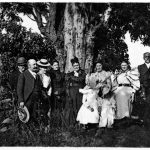Albemarle County

Judge Duke with members of his extended family, c. 1890, on a pilgrimage to Shadwell, the Albemarle County birthplace of Thomas Jefferson.
Colonial officials carved Albemarle County out of Goochland County in 1744, as Virginia settlers streamed westward towards the Blue Ridge. Settled early, Albemarle became a important inland seat of Virginia politics. Thomas Jefferson made his home, Monticello, within its boundaries, and James Madison and James Monroe settled just north. Due largely to Jefferson’s influence, the state established the University of Virginia there in 1819, replacing Williamsburg’s College of William and Mary as the preeminent state school.
The University, the patronage of Thomas Jefferson, and–later–the railroad, made Charlottesville the most important city in Albemarle County. Incorporated in 1762 and fixed along the primary route between the settled East and the Blue Ridge–“Three-Notch’d Road”–Charlottesville grew modestly until the arrival of the first railroad in 1850. By 1920, multiple lines served the city and connected Duke and his cohort to the rest of the state and region. In that year, the Southern Railroad alone ran sixteen passenger trains to and from Charlottesville’s Union Station each day. Four of these provided express service to Washington, and four to Atlanta. Duke could rightly boast that his little city had “waked up out of a long but pleasant sleep, and like a giant refreshed—dare I say with wine?—[was] taking great strides towards a higher usefulness and greater prosperity.”
Duke seized every occasion to declare his pride in inhabiting a county so marked by history and so flushed with commercial success. In 1918, for example, he delivered an address at St. Paul’s Episcopal Church in Ivy, Virginia to commemorate the 144th anniversary of Meriwether Lewis’ birth. “Few of the counties in this old Commonwealth have more reason to be proud of their illustrious sons than this county of ours,” he boasted. In 1922, he again paid public tribute to his home, when he was selected to welcome a delegation of distinguished visitors to Charlottesville. Although time has erased the identity of these visitors, Duke saved a copy of his address as printed in the local newspaper. In his elaborate way, he rejoiced “to bid you welcome to our little City which nestles in the cup of this lovely valley, like a diamond in emerald and sapphire settings.”
For additional information, see the Albemarle County Historical Society and the “Charlottesville Narrative,” an IATH project.
